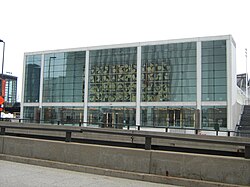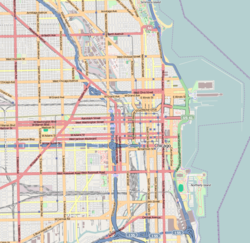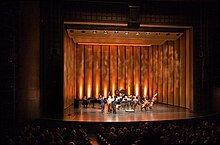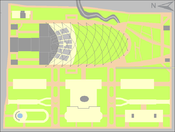
Wrigley Square is a public square located in the northwest section of Millennium Park in the Historic Michigan Boulevard District of the Loop area of Chicago in Cook County, Illinois, United States. The square is located at the southeast corner of the intersection of East Randolph Street and North Michigan Avenue. It contains the Millennium Monument, a nearly full-sized replica of the semicircle of paired Roman Doric-style columns that originally sat in this area of Grant Park, near Michigan Avenue and Randolph Street, between 1917 and 1953. The square also contains a large lawn and a public fountain.
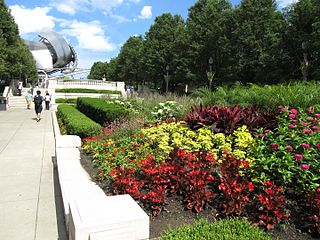
Millennium Park is a public park located in the Loop community area of Chicago, operated by the Chicago Department of Cultural Affairs. The park, opened in 2004 and intended to celebrate the third millennium, is a prominent civic center near the city's Lake Michigan shoreline that covers a 24.5-acre (9.9 ha) section of northwestern Grant Park. Featuring a variety of public art, outdoor spaces and venues, the park is bounded by Michigan Avenue, Randolph Street, Columbus Drive and East Monroe Drive. In 2017, Millennium Park was the top tourist destination in Chicago and in the Midwest, and placed among the top ten in the United States with 25 million annual visitors.

Parks in Chicago include open spaces and facilities, developed and managed by the Chicago Park District. The City of Chicago devotes 8.5% of its total land acreage to parkland, which ranked it 13th among high-density population cities in the United States in 2012. Since the 1830s, the official motto of Chicago has been Urbs in horto, Latin for "City in a garden" for its commitment to parkland. In addition to serving residents, a number of these parks also double as tourist destinations, most notably Lincoln Park, Chicago's largest park, visited by over 20 million people each year, is one of the most visited parks in the United States. Notable architects, artists and landscape architects have contributed to the 570 parks, including Daniel Burnham, Frederick Law Olmsted, Jens Jensen, Dwight Perkins, Frank Gehry, and Lorado Taft.
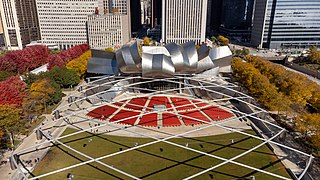
Jay Pritzker Pavilion, also known as Pritzker Pavilion or Pritzker Music Pavilion, is a bandshell in Millennium Park in the Loop community area of Chicago in Cook County, Illinois, United States. It is located on the south side of Randolph Street and east of the Chicago Landmark Historic Michigan Boulevard District. The pavilion was named after Jay Pritzker, whose family is known for owning Hyatt Hotels. The building was designed by architect Frank Gehry, who accepted the design commission in April 1999; the pavilion was constructed between June 1999 and July 2004, opening officially on July 16, 2004.

The Chicago Opera Theater (COT) is an American opera company based in Chicago, Illinois. COT is a resident company at the Harris Theater for Music and Dance in Chicago's Millennium Park and is currently in residence at the newly renovated Studebaker Theater in the historic Fine Arts Building. In addition to productions of selected operas from the core opera repertoire, COT has an emphasis on American composers, Chicago premieres, and producing new contemporary operas for a 21st-century audience.

The Grant Park Music Festival is a ten-week classical music concert series held annually in Chicago, Illinois, United States. It features the Grant Park Symphony Orchestra and Grant Park Chorus along with guest performers and conductors, and claims to be the only free outdoor classical-music concert series in the US. The Festival is a non-profit organization. The Festival has been a Chicago tradition since 1931, when mayor Anton Cermak suggested free concerts to lift spirits of Chicagoans during the Great Depression. The tradition of symphonic Grant Park Music Festival concerts began in 1935.
Chicago Festival Ballet is a professional ballet company performing a repertoire of classical, romantic and neoclassical works in venues around the United States. Chicago Festival Ballet is also known as Von Heidecke's Chicago Festival Ballet. Chicago Festival Ballet's sister organization and educational arm is the Von Heidecke School of Ballet.

The Toledo Alliance for the Performing Arts was created in 2019 when the Toledo Symphony Orchestra and the Toledo Ballet merged. Based in Toledo, Ohio, it operated with a $13.2 million budget in its fiscal year 2020 and maintains the two brand names Toledo Symphony (sic) and Toledo Ballet, each with its own website. The orchestra part of TAPA performs at various venues, including the Toledo Museum of Art Peristyle Theater, the Valentine Theatre, the Toledo Club, the Stranahan Theater and some twenty churches and performing arts centers across the region.

The BP Pedestrian Bridge, or simply BP Bridge, is a girder footbridge in the Loop community area of Chicago, United States. It spans Columbus Drive to connect Maggie Daley Park with Millennium Park, both parts of the larger Grant Park. Designed by Pritzker Prize-winning architect Frank Gehry and structurally engineered by Skidmore, Owings and Merrill, it opened along with the rest of Millennium Park on July 16, 2004. Gehry had been courted by the city to design the bridge and the neighboring Jay Pritzker Pavilion, and eventually agreed to do so after the Pritzker family funded the Pavilion.
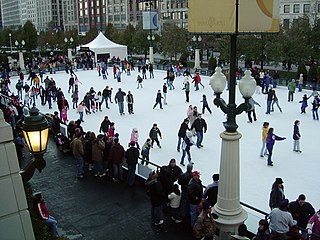
McCormick Tribune Plaza & Ice Rink or McCormick Tribune Plaza is a multi-purpose venue within Millennium Park in the Loop community area of Chicago, Illinois, in the United States. On December 20, 2001, it became the first attraction in Millennium Park to open. The $3.2 million plaza was funded by a donation from the McCormick Tribune Foundation. It has served as an ice skating rink, a dining facility and briefly as an open-air exhibition space.

AT&T Plaza is a public space that hosts the Cloud Gate sculpture. It is located in Millennium Park, which is a park built to celebrate the third millennium and which is located within the Loop community area of Chicago, Illinois in the United States. The sculpture and the plaza are sometimes jointly referred to as Cloud Gate on the AT&T Plaza.

The Exelon Pavilions are four buildings that generate electricity from solar energy and provide access to underground parking in Millennium Park in the Loop community area of Chicago in Cook County, Illinois, United States. The Northeast Exelon Pavilion and Northwest Exelon Pavilion are located on the northern edge of the park along Randolph Street, and flank the Harris Theater. The Southeast Exelon Pavilion and Southwest Exelon Pavilion are located on the southern edge of the park along Monroe Street, and flank the Lurie Garden. Together the pavilions generate 19,840 kilowatt-hours (71,400 MJ) of electricity annually, worth about $2,350 per year.
Luna Negra Dance Theater was a dance ensemble that celebrated the richness and diversity of Latino culture through the creation of works by contemporary Latino choreographers. Founded by Cuban-born dancer and choreographer Eduardo Vilaro, the company steered away from folkloric representations and utilized a variety of dance form styles such as Flamenco, Tango, or Salsa with contemporary dance movement.
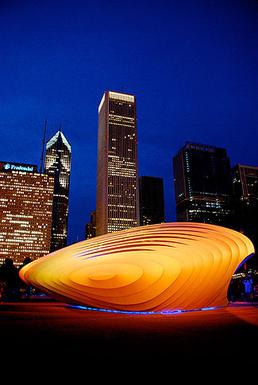
The Burnham Pavilions were public sculptures by Zaha Hadid and Ben van Berkel in Millennium Park, which were located in the Loop community area of Chicago, Illinois. Both pavilions were located in the Chase Promenade South. Their purpose was to commemorate the 100th anniversary of Daniel Burnham's Plan of Chicago, and symbolize the city's continued pursuit of the Plan's architectural vision with contemporary architecture and planning. The sculptures were privately funded and reside in Millennium Park. The pavilions were designed to be temporary structures.
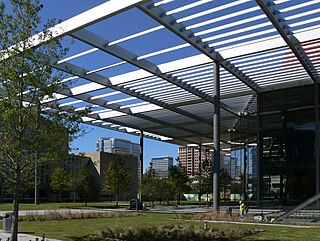
The AT&T Performing Arts Center in Dallas, Texas, preliminarily referred to as the Dallas Center for the Performing Arts, is a $354-million multi-venue center in the Dallas Arts District for performances of opera, musical theater, classic and experimental theater, ballet and other forms of dance. It opened with a dedication by city leaders on October 12, 2009.
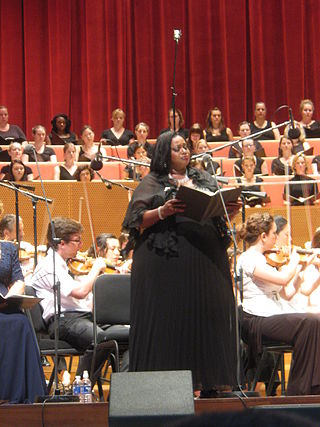
Jonita Lattimore is an American operatic soprano and a faculty member of Roosevelt University's Chicago College of Performing Arts. She is a lyric soprano from Chicago's South Side who has performed a wide range of operatic roles, as well as oratorio performances with major orchestras both internationally and domestically.
The MCA Stage is the Museum of Contemporary Art, Chicago’s performing arts program. Founded in 1996 with the opening of the MCA’s new building in Chicago, Illinois.
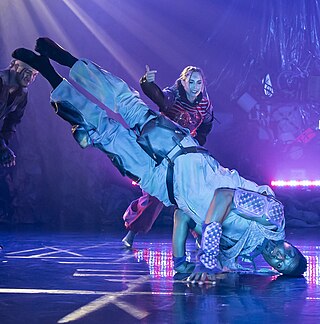
Chicago Dance Crash is an American hip hop/contemporary dance company based in Chicago, Illinois. The company tours year round while sustaining a calendar year ‘season’ of local premiers and commercial work as well as a spring/fall educational outreach program. The company has received widespread critical acclaim while being considered one of the most notable American dance companies to emerge during the first decade of the 2000s.
The Chicago Philharmonic is an American orchestra based in Chicago, Illinois, governed by the Chicago Philharmonic Society. Founded in 1988 by principals of the Lyric Opera Orchestra of Chicago, it is a musician-governed, non-profit organization consisting of nearly 200 classical music performers from the Chicago area. Since 2013, the Artistic Director and Principal Conductor has been Scott Speck.
